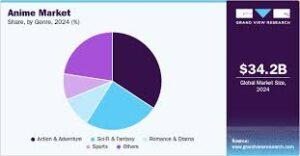Anime dominance is no longer just a pop culture buzzword—it’s a global phenomenon. What began as a niche form of Japanese animation has now transformed into a powerhouse that has reshaped entertainment industries across the globe. From Netflix to global conventions, anime is everywhere. But how exactly did this transformation happen? Let’s explore the story behind anime’s rise and how it captured the hearts of millions worldwide.
What Sparked the Global Anime Dominance?

Anime’s journey began in Japan, but its influence quickly spread. The early 90s introduced anime to the West with titles like Dragon Ball Z, Pokémon, and Sailor Moon. As streaming services like Crunchyroll, Funimation, and Netflix began distributing anime globally, the popularity exploded.
According to Statista, the Japanese anime industry was worth over $34.2 billion in 2024, proving that anime dominance isn’t just cultural—it’s economic.
Streaming Services Fueling Anime’s Global Reach
The rise of streaming services played a pivotal role in anime dominance. Platforms like:
-
Netflix invested heavily in anime originals such as Castlevania and Yasuke.
-
Crunchyroll offers one of the largest legal anime libraries globally.
-
Amazon Prime Video and Hulu have also joined the anime bandwagon.
These platforms introduced millions of users to anime, breaking geographical and linguistic barriers.
Social Media & Fandom Culture
From TikTok edits to Instagram fan art and Twitter trends, anime has taken over social platforms. Hashtags like #AnimeDominance and #AnimeTakeover trend regularly as fan communities grow globally.
Communities on Reddit’s r/anime or Discord anime servers are thriving, creating strong fan bases that fuel continuous engagement. Anime conventions such as Anime Expo, Comiket, and Japan Expo are selling out in record time—signs of anime dominance in real life, not just online.
Cultural Impact Beyond Entertainment
Anime isn’t just about cartoons. It has become a cultural ambassador for Japan. Shows like Demon Slayer, Naruto, and Attack on Titan have:
-
Increased tourism in Japan
-
Influenced global fashion trends
-
Inspired music videos and Hollywood films
Fashion brands like Uniqlo and Gucci have collaborated with anime franchises. This mainstream acceptance proves that anime dominance goes beyond entertainment—it affects lifestyle and identity.
Educational and Psychological Value
Educators and psychologists have begun to recognize the educational and emotional depth in anime. Shows like:
-
Your Lie in April teaches emotional intelligence and loss.
-
Erased and Death Note explore psychology and justice.
-
My Hero Academia promotes resilience and mentorship.
These aren’t just entertaining shows—they’re stories that teach and inspire. This depth is another reason behind anime dominance in educational spaces and among young adults.
Why Anime Dominance Is Here to Stay
Cross-Cultural Appeal
Anime blends diverse themes—romance, action, comedy, philosophy—appealing to all age groups. It’s this universal storytelling that ensures anime remains relatable across the globe.
Ever-Expanding Content Universe
With new genres like Isekai, Slice of Life, and Cyberpunk anime, content creation has no limits. Every year brings fresh stories that keep fans hooked and the market expanding.
Why Anime Dominance Isn’t Slowing Down
With the anime market expected to grow even further—estimated to surpass $30 billion globally in the next few years—this cultural wave isn’t going anywhere. New genres like Isekai (other-world adventures), Slice of Life, and Cyberpunk Anime continue to attract diverse fan bases.
Anime’s flexibility in storytelling, paired with high production value and global accessibility, ensures its staying power. Whether it’s being watched on a phone in Brazil, a laptop in Germany, or a cinema in Japan, anime dominance is a shared global experience.
To explore more about anime and its rise:
-
Learn the History of Anime
-
Browse the best anime on MyAnimeList
Conclusion: The Future of Anime Dominance
From a niche Japanese art style to a dominant global entertainment force, anime has cemented itself in the world’s cultural DNA. With dedicated fans, diverse stories, and massive platforms supporting it, anime dominance isn’t fading—it’s evolving.
Whether you’re a lifelong fan or a curious newcomer, now is the best time to dive into the vast and colorful world of anime.
Also check out related content:

